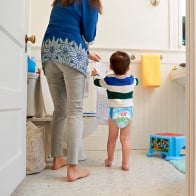Cautious
How To Get Started Potty Training Your Cautious Child
18 Jan, 2023
2 min. Read
Give your process-oriented kid the step-by-step walkthrough of how you use the toilet yourself. Talk about your process as much as possible. Help your methodical child understand the cues their body is giving to them for when it’s time to go. Tell them this will help them start learning to go to the bathroom like a Big Kid. Take your careful child into the bathroom with you, and allow them to explore while you’re using it. Explain to your detailed kid what each piece of equipment is, and how it works, before you use it. Talk about how you know when it’s time for you to go. Don’t hold back in explaining how it feels, what you do to get ready to go, and what you do afterward with the all-important flush and hand washing. If you’re a dad, uncle, grandfather or other male caregiver working with a little boy, it is best to do the play-by-play while sitting down. Standing to pee is an advanced skill better left for later in the potty training.
As you begin potty training, make sure to dress your child in comfortable clothes that are easy to get on and off. This will help your child get to the potty in time when they’re ready, especially if they happen to be running to the potty last minute. Save the overalls, tights, ball gowns or neoprene wetsuits for another era.
Look for books that explain the potty process with lots of pictures, and keep them handy for your cautious child to analyze. They like to review the all the details. The more they understands the potty routine, the more confident they’ll be following it. Verbally label each component of the bathroom and tell your child what it’s for. This develops your child’s vocabulary, and gives him the words to communicate effectively with you about the potty process. Use “Build a Bathroom” puzzle cards as part of the Pull-Ups Potty Training Program.
After you’ve identified the parts of the bathroom, have a conversation with your methodical child that helps them process all the new information, and share with you what they’ve learned. Ask them what he’d like to learn more about. Next, have them teach someone else, like another parent, a friend or another adult, all about the features of the bathroom. Make them the expert, and your detailed child will act like one.
Use Potty Time Sequencing Picture Cards“What do we do first? Next?” Put the cards together to create a step-by-step pottying process.
If you have a small potty chair, invite your child to sit alongside you and do what you’re doing. This will help your cautious kid to feel like they are part of the process and “doing it right!” Help her talk through the steps, but be gentle and remember not to pressure her too much.
Create an interactive experience for your careful child. Point at something in the bathroom and ask, “What’s this? What do we do with it?” Your child’s responsiveness will depend on how verbal they are at this point in her development. Answer the questions together, modeling the language you want to see them use, and take this opportunity to connect with your child. Potty training is a great way to build the relationship with your process-oriented kid; it shows them that they can depend on you in helping make sense of the world, with all its crazy parts and pieces.
“Part of using the potty is knowing how your body feels when you have to go. I know I have to go to the bathroom when my tummy feels tight and heavy. I have to squeeze my tummy from the inside to keep the pee or poop from coming out until I get to the toilet. Do you ever feel your pee or poop coming? It helps to put a hand on your tummy to check. How does it feel in there? Once I sit down on the potty, I can stop holding my tummy tight and let it all go. Ahhhh. This helps my pee or poop come right out into the toilet! When you think you have to go, tell me so I can help you try, too. You're doing great so far. It’s so cool that you’re learning all this Big Kid stuff.”
As you begin potty training, make sure to dress your child in comfortable clothes that are easy to get on and off. This will help your child get to the potty in time when they’re ready, especially if they happen to be running to the potty last minute. Save the overalls, tights, ball gowns or neoprene wetsuits for another era.
Potty Script:
- “I put my pee and poop in the toilet. After I go, I wipe myself with toilet paper to keep myself clean.”
- “This is how to flush the toilet. I push this handle down. When I flush the toilet, the bowl fills with water and takes everything I put into the toilet away to a special place. See how it swirls around and then goes down? Next time you can help me flush. And every time you come to the potty you get to flush your own. That’s how everyone goes potty.”
When you’re in the bathroom with your cautious child, don’t rush to flush. Your child may want to analyze your output. Welcome him to do so and talk about attributes such as color, size, volume and smell. Detail oriented children sometimes get hung up on the idea of ‘messes,’ and this will help your kid learn that pee and poop are natural parts of life.













